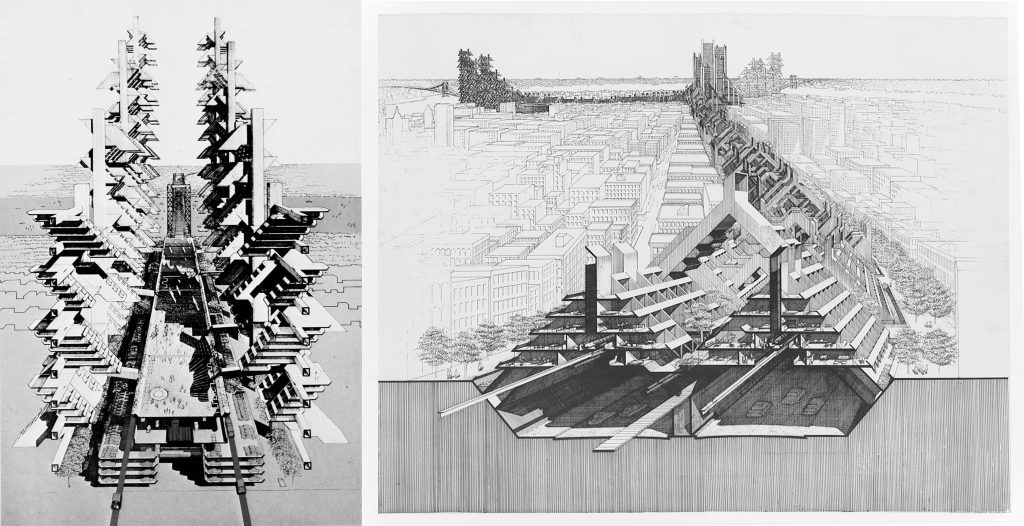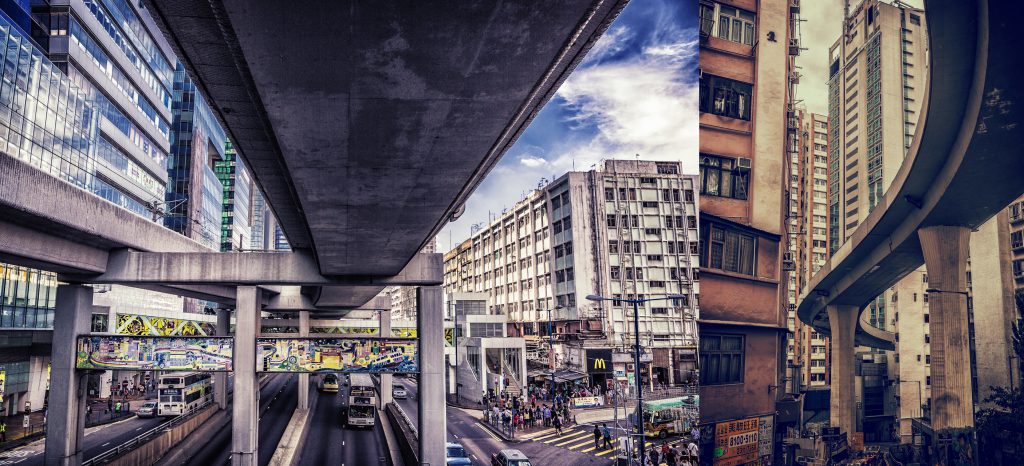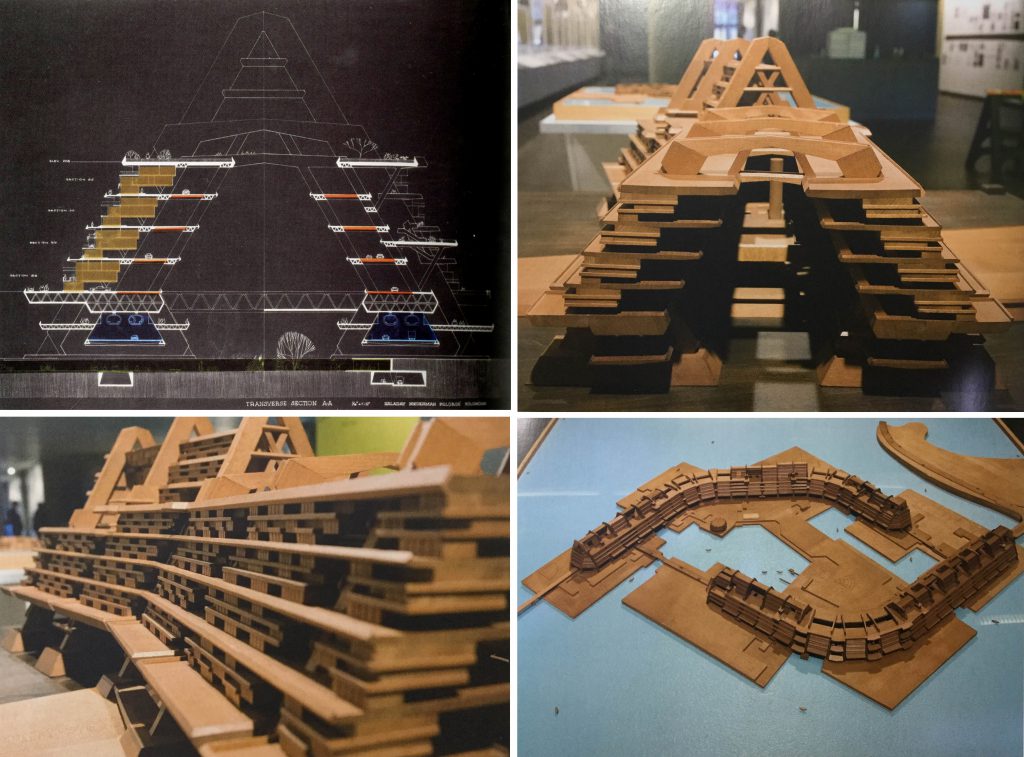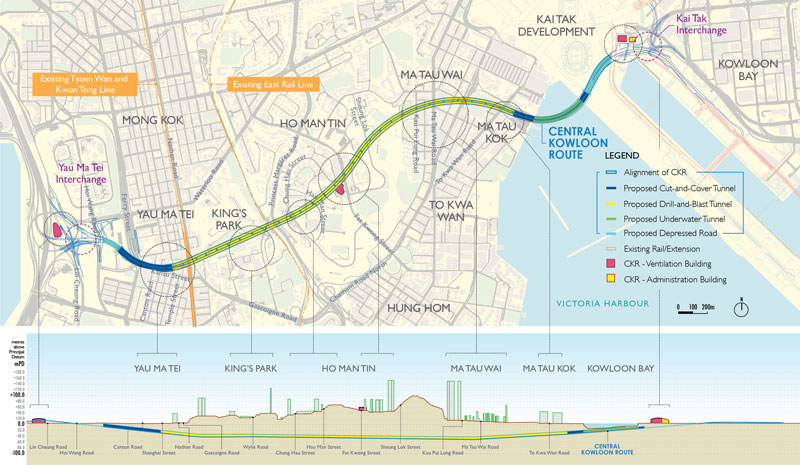|
|
1.0 THESIS STATEMENT
This thesis explores the potential of building WITH flyovers, and seeks to propose a megaform as a prototype that hybridizes flyovers, buildings and landscape.
It is a response to the current disjunctions created by flyovers within high-density cities. This thesis re-imagines flyovers as an active urban spine with an intrinsic place-creating character that can propagate further urban developments and establish a more integrated urban environment.
2.0 WHAT?
Highways, particularly flyovers, knit cities together as much as they tear them apart. Cities and neighbourhoods, consequently, are left in dis-junctions and fragmentations – physically, functionally and socially.
“If architectural design could get into the act somehow, it could help resolve ‘the insoluble problem of the modern city’… In the guise of ‘urban design’, the exercise of architecture on a very large scale might bridge the gap between the single building and its dis-integrating urban context. At that point of resolution and despair, the ‘city as a single building’ became a re-thinkable concept and mega-structure was its appointed form.” – Reyner Banham
This thesis thus positions itself with the belief that the boundary between highways, buildings and landscape must dissolve to achieve a more integrated urban environment. A hybridized relationship shall be established and manifested in a new mega-structural form that rethinks the form, structure, tectonics, scale, programmes, space and events of the three as a holistic entity.
With changing modes of transportation in near future and thus the need of such infrastructure to accommodate flexibility, this thesis shall project itself into the next 10-20 years.
Highways, instead of being just a traffic carrier, are re-envisaged as an active urban spine that not only organizes programmes and the total form but also capable of giving drama, possibilities, form and a sense of place to the city.

Paul Rudolph. Lower Manhattan Expressway. 1973-1974.
(Source: http://linesandmarks.com/tag/modernist-architecture/)
3.0 WHY?
“A city exists, not for the constant passage of motorcars, but for the care and culture of men.” – Lewis Mumford
Highways were developed in the early 1920s as a response to the increasing use of the automobile. While it has been widely acknowledged and celebrated in the media for its efficiency and urban connectivity, it brings with it pollution, street sleepers, dark undersides, crimes as well as an incompatible scale. With its sole concern for the automobile, highway infrastructure may be a magical space for drivers and passengers but it certainly creates an undesirable urban environment for pedestrians and inhabitants. The contemporary architectural practice of dis-engaging buildings from highways is unsustainable since the results have been and will continue to be a saturated landscape of countless windowless boxes, blank walls and sound barriers lining the way.
Highways have always been thought of only as traffic carriers. With its scale, network and structural capacity, they shall have more to offer.
In addition, with rapid technological advancements, new transportation means are expected in near future, implying a possible reform of transportation infrastructural system. How can highways respond to the future filled with emerging innovations like electric cars, self-driving cars and even a car-sharing network? How can it regenerate itself when traditional cars become obsolete one day?
At a time when the singularity of highways and buildings fails to match with the progressiveness and multiplicities of urban living, when architecture and infrastructure are felt to be drifting away from people and dissolving the sense of a city, it becomes crucial and urgent for us architects to devise a new urban strategy regarding the relationship between buildings, highways and landscape.

Karma Cheng. Flyovers of Hong Kong. In Flyover the Metropolis. July 29, 2014. Accessed September 23, 2016. https://stampsy.com/stamp/8246.

Giovanna Giuliano. Smart cars will need smart roads that share data on traffic, parking and recharging. In WIRED. November 7, 2016. Accessed November 7, 2016. http://www.wired.co.uk/article/smart-cars-need-smart-streets.
4.0 HOW?
This thesis proposes a megaform as a prototype that hybridizes flyovers, buildings and landscape. Apart from retaining existing programmes, it also proposes new ones that can potentially be brought about.
While highways are constructed in sections and city spaces are also experienced through sections in both vehicular and pedestrian motions, the megaform shall also be conceived primarily in sections, and composed of a series of sectional prototypes.
The methodology of the study shall revolve around a sectional exploration in form, space, tectonics and programmatic distribution of the hybrid prototype through modelling. It will focus on 2 to 3 key sections based on site context.
4.1 RESEARCH
-
Understanding flyovers in general: the essential components, critical design requirements, processes of construction, assembly, operation and maintenance of highways
- 1:50 study model of a typical section
- Exploded axonometric
-
Understanding flyovers in the context of Hong Kong
- Timeline study of highway development in HK, including its history, future master-plans and any related government policies/laws
-
Understanding the site
- Mapping analysis of the existing urban fabric, topography, programmes, transportation systems, history, demographics, circulation patterns, outline zoning plan, etc.
- Sectional study of the current relationship between flyovers and buildings (activities, circulation patterns, critical dimensions)
-
Case Studies
- Precedents of mega structural / megaform projects
- Local/Overseas, Top-down/Bottom-up attempts to utilize spaces under and around flyovers
- Future transportation innovations (e.g. electric cars, self-driving cars)
4.2. DESIGN
-
Site Strategy
- Defining schedule of programmes, users and overall site strategy
- Deliverables: Conceptual collage or drawing
-
[Single Prototype] Form Finding, Structural & Tectonic Explorations
- Explorations in configurations of the sectional profile with design parameters
- Deliverables: 1:50/1:100 physical massing and tectonic models
-
[Single Prototype] Detail Design
- Explorations with closer looks into the spaces within and materiality
- Deliverables: 1:50 physical tectonic models
-
[Assembly Prototype] Plugging onto site
- Assembly of a series of sectional prototypes placed onto site
- Deliverables: 1:200 partial tectonic models
-
[Urban Form] Re-envisaged urban form of selected site
- Investigation in how the megaform can be populated and expanded across the site
- Deliverables: 1:500/1:1000 re-envisioned urban form of site

Kenzo Tange, Typical A-frame section and models for Boston Harbour Project, 1960
(Source: Seng Kuan, and Yukio Lippit. Kenzo Tange: Architecture for the World. Baden: Lars Müller, 2012.)
4,3 Test Site – Central Kowloon Route (from Yau Ma Tei to Kai Tak)
Central Kowloon Route (CKR) is a proposed road in Central Kowloon linking Yau Ma Tei in West Kowloon with Kai Tak and Kowloon Bay in East Kowloon. Considering minimal demolition and minimal impacts on the visual, traffic, land use and environment, it has been proposed to be a tunnel for the majority portion instead of a flyover.
By adopting this site, the thesis shall propose a counter-proposal of an elevating approach as opposed to the current digging strategy. It envisions a phase-by-phase sectional redevelopment of the various districts with the insertion of the flyover.
3 typical sections along the route shall be studied in detail and developed further.
 Masterplan of CKR. Highways Department, HKSAR. 2014. Masterplan of CKR. Highways Department, HKSAR. 2014.
<http://www.ckr-hyd.hk/>
5.0 REFERENCE PROJECTS / PRECEDENTS
- Ponte Vecchio, Florence, Italy (Architect unknown, 1345)
- Plan for Algiers (Le Corbusier, 1888)
- Scheveningen New Pier, Rotterdam (Hugh Maaskant and Dick Apon, 1959)
- Boston Harbour Project (Kenzo Tange, 1959-60)
- A Plan for Tokyo 1960 (Kenzo Tange, 1960-61)
- Motopia (Geoffrey Alan Jellicoe, 1960)
- City Interchange Project (Archigram, 1963)
- Plug-in City (Archigram, 1965)
- Lower Manhattan Expressway Proposal (Paul Rudolph, 1970)
- Yokohama Ferry Terminal (Foreign Office Architects, 2002)
- Jin-Mei Parasitic Pedestrian Pathway across Yilan River (Huang Shengyuan & Fieldoffice Architects, 2008)
- High Line Park (James Corner/Field Operations and Diller Scofidio + Renfro, 2009)
- Diu Diu Dang Public Promenade under the Lifted Railway in Yilan (Huang Shengyuan & Fieldoffice Architects, 2010)
6.0 BIBLIOGRAPHY
-
Reyner Banham. Megastructure: Urban Futures of the Recent past. (New York: Harper and Row, 1976.)
-
Lewis Mumford. The Highway and the City. (New York: Harcourt, Brace & World, 1963.)
-
Jane Jacobs. The Death and Life of Great American Cities. (New York: Random House, 1961.)
-
Kenneth Frampton. Megaform as Urban Landscape. (Ann Arbor, MI: University of Michigan, A. Alfred Taubman College of Architecture + Urban Planning, 1999.)
-
Stan Allen. “Infrastructural Urbanism”, Points + Lines: Diagrams and Projects for the City. (New York: Princeton Architectural Press, 1999.)
-
Kevin Lynch. The Image of the City. Cambridge, MA: MIT Press, 1960.
-
Donald Appleyard, Kevin Lynch, and John Randolph Myer. The View from the Road. (Cambridge, MA: MIT Press, 1965.)
-
Mitchell Schwarzer. Zoomscape: Architecture in Motion and Media. (New York: Princeton Architectural Press, 2004.)
-
Edward Dimendberg. “The Will to Motorization: Cinema, Highways, and Modernity: For Wolf Donner, in Memoriam.” (October 73 (1995): 90-137. doi:10.2307/779010.)
-
Marc Augé. Non-places: Introduction to an Anthropology of Supermodernity. (London: Verso, 1995.)
-
Kelly Shannon, and Marcel Smets. The Landscape of Contemporary Infrastructure. (Rotterdam: NAi Publishers, 2010. )
-
Christopher C. M. Lee, and Sam Jacoby. Typological Urbanism.( Chichester: Wiley, 2011.)
-
David Gissen. Subnature: Architecture’s Other Environments. New York: Princeton Architectural Press, 2009.
-
Bernard Tschumi. “Space and Events”, Architecture and Disjunction. (Cambridge, MA: MIT Press, 1994.)
-
Luke Dormehl. “The Road to Tomorrow: Streets Need to Be as Smart as the Cars Driving on Them.” WIRED. November 7, 2016. Accessed November 7, 2016. http://www.wired.co.uk/article/smart-cars-need-smart-streets.
-
Sam Lubell. “Here’s How Self-Driving Cars Will Transform Your City.” WIRED. October 21, 2016. Accessed November 7, 2016. https://www.wired.com/2016/10/heres-self-driving-cars-will-transform-city.
|